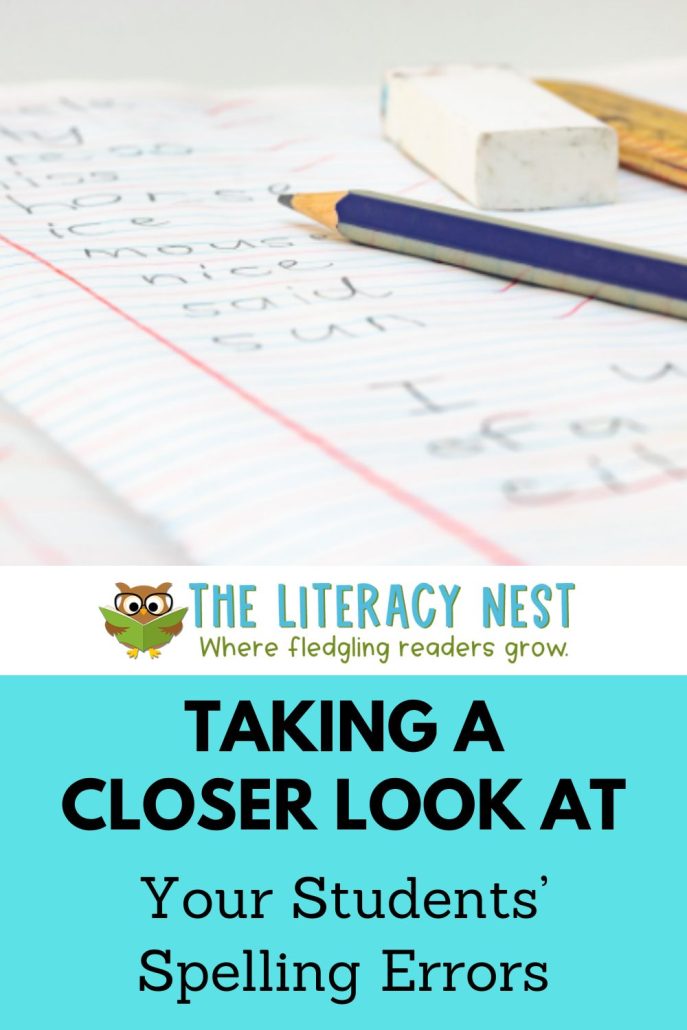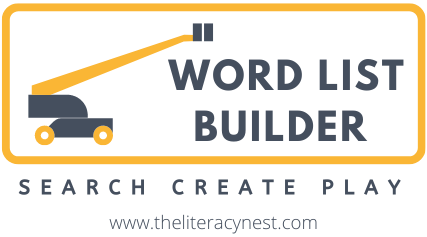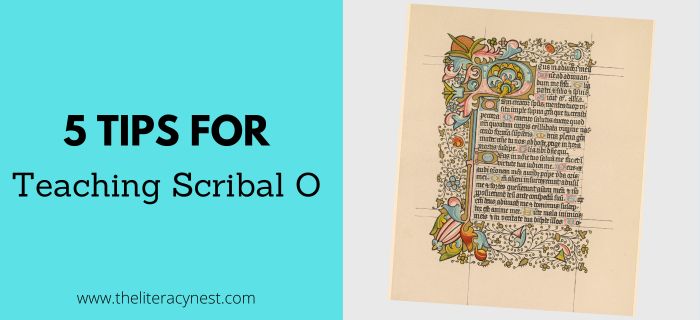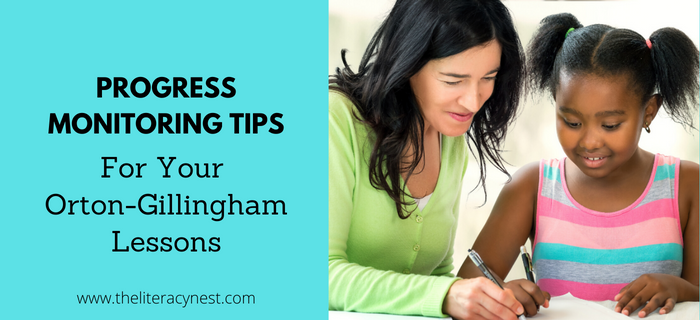Taking a Closer Look at Spelling Errors: How a Spelling Assessment Can Inform Your Instruction
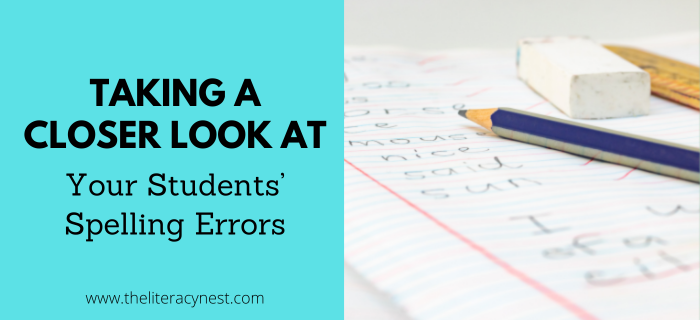
You will find most teachers of children with dyslexia are not fans of the weekly spelling test. Words arranged by theme or covering multiple spelling patterns is a recipe for failure for many of our students. Other students may manage to learn the words for the Friday spelling test, but not be able to spell those same words the next week. We know what is NOT helpful. But what IS useful? How can a spelling assessment inform us?
(This post contains affiliate links.)
Why?
Not all spelling assessments are created equal. The type of spelling assessment that I find most useful is a spelling inventory. This is different than a spelling test in several ways. Most importantly, it is diagnostic. Words in a spelling inventory are chosen to uncover what types of errors students make the most.
By analyzing your student’s answers, we gain insight into their phonological awareness, their decoding and encoding skills, and even their fine motor skills. There is no studying for a spelling inventory. The goal isn’t to get 100% or spell words correctly from memory. The goal is to get a glimpse into the processing happening inside the student’s brain.
The real work in a spelling inventory belongs to the teacher. Actually giving the inventory is the fastest part. Analyzing student spelling, patterns of errors, and types of errors is more time-consuming and require much more careful thought than marking words right or wrong.
What Are Some Suggested Assessment Tools?
There are 3 common spelling inventories you will find helpful.
Gallistel Ellis
One that I like to administer to each of my students as part of the intake process is the Gallistel Ellis. One of my favorite things about this assessment is that words are divided into categories that align nicely with Orton-Gillingham instruction. It is easy to see if students are accurately applying the skills they have learned in their Orton Gillingham instruction.
Another nice feature of this assessment is the ability to look at these skills in both reading and writing. Typically, students make more rapid progress toward mastery in decoding than in encoding. Spelling development may lag somewhat behind reading, but this assessment is sensitive enough to show partial mastery. There are clear assessment ceilings so a child is not subjected to lengthy frustration as they attempt skills that are too difficult.
Words Their Way
Another common tool is the Words Their Way spelling inventory. This is a free tool. It’s comprised of a spelling list of 25-30 words. It is time efficient in that it can be administered to a whole group or class simultaneously. This inventory covers a large range of skills. There are 3 levels of spelling inventory that zoom in on three different difficulties of skills. The primary spelling inventory, elementary inventory, and upper-level inventory. The focus shifts along the Words Their Way developmental spectrum from Letter Name Alphabetic to Derivational Relations. And full disclosure- I don’t use WTW with my Orton-Gillingham students, but the spelling inventory is a useful tool.
DSA by Ganske
A third spelling inventory is the DSA (Developmental Spelling Analysis) by Ganske. This can be found in Word Journeys Kathy Ganske. This assessment starts with a 20-word screener. This is similar to the WTW inventory. Based on this score students are given a feature-level assessment that takes a deeper dive into the spelling features for that stage. This aspect is more similar to the GE. There are two separate test forms making this particularly useful for ongoing assessment.
This assessment is also particularly useful for students who have partial mastery of many things. When a child has mastered a level or knows little about a particular spelling feature, it is easy to know where to start, but when their knowledge is incomplete, this becomes a more challenging task. This assessment tool provides a lot of support for the teacher analyzing the spelling.
Watch this video for tips for dictation. And check out the Literacy Nest Video Vault if you’re looking for Orton-Gillingham videos to find ideas for your reading instruction.
When Should You Give It?
You may choose to administer the Gallistel Ellis annually. This gives your students enough time to learn enough concepts so that the assessment reflects their learning and progress. Each level of the GE test may represent a lengthy period of instruction. Since there is a single testing form, it is advisable to refrain from using the assessment too frequently.
The Words Their Way inventory is intended for initial placement at the beginning of the school year. Like the GE, it has a single testing form per level and excessive exposure to the assessment should be avoided. The inventory is unlikely to be sensitive enough to capture mastery of individual spelling features. The Words Their Way program does include spell checks that can be used as pre and post-tests after a particular group of sorts. These could also be used to check student understanding of particular orthographic features. ;
The DSA has 2 forms both for the screening tool and the various feature inventories. This makes it particularly well suited for periodic assessments such as the beginning of the year, the end of the marking period or trimester, and the end of the year. Alternating the forms ensures it will not become overly familiar.
For more on progress monitoring, Tips For Monitoring Your Orton-Gillingham Lessons provides further recommendations.
What Can A Spelling Inventory Tell Us?
Two words: A LOT! 🙂
A spelling inventory can give us a great deal of information if we analyze it carefully. The inventory can tell us what developmental stage the child is at as a speller or particular spelling patterns they have mastered, but when we look carefully at the errors, we gain even more insight.
Ask yourself this question: “What are these spelling errors telling me about this student?”
Errors can be broken down into three categories.
1. Phonological errors
Phonological errors are errors related to the sound of words. This could be a failure to represent a particular sound or representing a sound incorrectly. For example: fn for fan, pit for pet, sed for sled, and chip for ship are all phonological errors. The student in this example had difficulty segmenting all of the sounds in fan and sled and had difficulty differentiating between similar sounds such as /ĭ/ and /ĕ/ or /sh/ and /ch/.
2. Orthographic errors
Orthographic errors are often a bit more sophisticated errors. In these errors, students may have used letters that CAN make a particular sound, but not the correct spelling for this situation. Examples of this type of error would include: stik for stick, dreme for dream, and koatch for coach. The student in these examples had difficulty applying the k/ck spelling rule, making a spelling choice for the long e sounds, and using the initial c/k spelling generalization, and the ch/tch rule. These errors tend to be easier to sound out and figure out what the student intended to write.
3. Morphological errors
Morphological errors may be trickier to spot and may also be phonological or orthographic. Some examples of morphological errors would include: wisht for wished, chood for chewed, and inprove for improve. Errors may be with derivational or inflective suffixes, chameleon prefixes, or final stable syllables as in educashun for education. Errors may also occur with roots as in fleksible for flexible.
Download our printable guide to the three types of spelling errors with examples.
What Are The Next Steps?
A student’s errors are going to reveal what type of instruction they need. Use a spelling assessment to plan lessons with a diagnostic and prescriptive approach.
- Students with many phonological errors need more work on phonemic awareness such as segmenting, blending, and manipulating phonemes. They need practice differentiating similar phonemes and may benefit from specific instruction about voiced and unvoiced pairs and mouth position in the formation of sounds. Many children struggle with short vowel sounds and need intensive vowel review.
- Students with more orthographic errors need more direct instruction and practice with syllable types, syllable division, spelling generalizations, and spelling patterns. This is an area that I notice many students need ongoing review and practice. Spelling generalizations often rear their heads as students spend time and energy on more complex concepts. Fortunately, working on regular review and practicing spelling generalizations in lessons can be done quickly and efficiently. I try to warm up each day with one of our spelling generalizations.
- Students with more morphological errors may need more support with language development and vocabulary. They may be showing you that they are ready for more instruction in morphemes. Some of the same students that may have more difficulty with the phonological aspects of language may do very well with morphology and find spelling based on morphology comes easily to them. The way in which a few morphemes can combine in a multitude of ways to spell related words is exciting and encouraging to struggling readers and writers.
For more on giving corrective feedback, read: The Importance of Giving Corrective Feedback.
Your Spelling Assessment Toolkit
A spelling assessment is just one tool in your collection. However, it provides powerful insight into areas that a student may be struggling with both broadly and on an individual item basis. Whether you are required to use a Words Their Way spelling inventory for your school or choose to use the Gallistel Ellis to plan your Orton-Gillingham sequence for a student, I encourage you to spend some time with your student’s spelling to help inform your instruction.
Check out my TpT store to find even more spelling resources.
Looking At Student Work
One of THE MOST valuable ways to learn more about the types of student spelling errors is to look at a collection of student work samples with a group of educators. This is especially important if you are new to looking at student work and categorizing errors as phonological, orthographic, or morphological. This PDF by Louisa Moats called, “Beyond Standardized Test Scores” is a helpful guide as your look more closely. I promise that once you practice with some work sample collections, you’ll definitely be more prepared when it comes time to look at your own class.
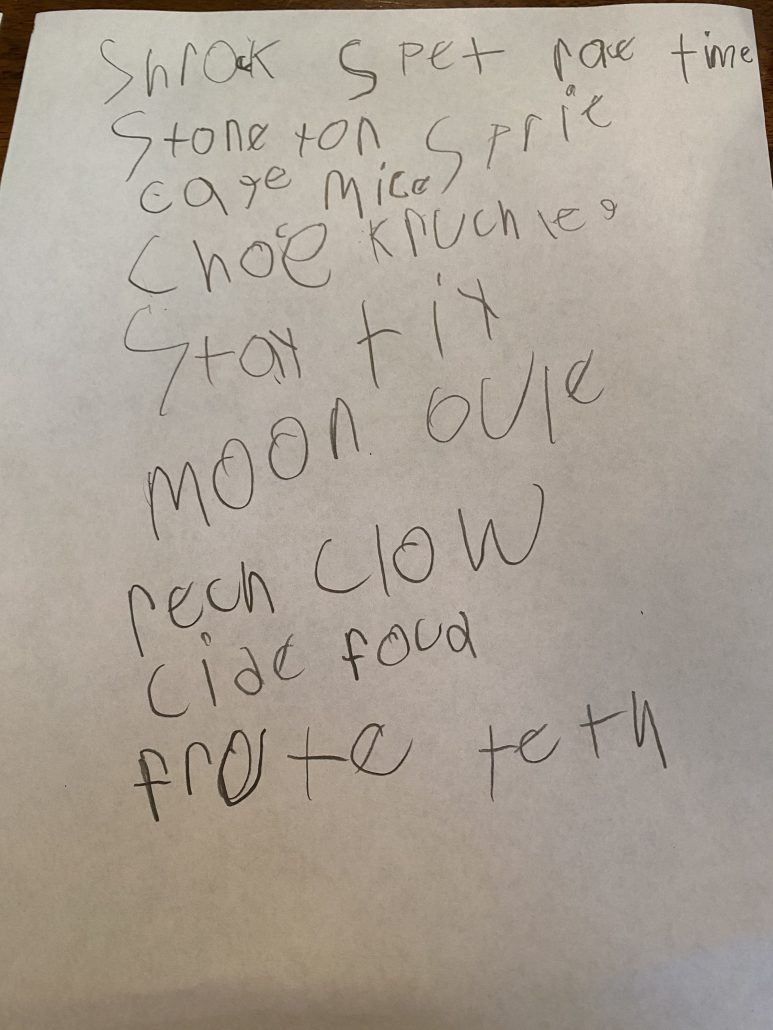

More On Assessment
Spelling inventories are useful for ALL students, not just the ones receiving Orton-Gillingham intervention. When you are seeking to find a starting point in Orton-Gillingham lessons, a spelling inventory is one useful tool. For more information on assessing, How To Find A Starting Point in Orton-Gillingham explains more about other assessments I’ve used.
Are you looking to customize your spelling instruction? Word List Builder has got you covered!
Save time, search and build your folder of words, create templates and games, too, using Word List Builder!
